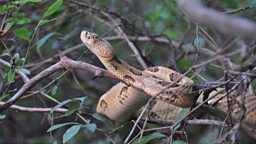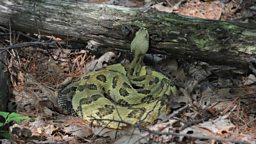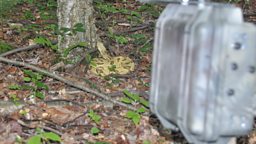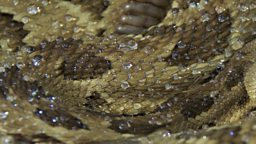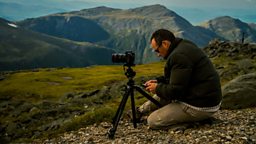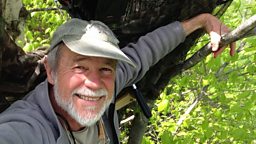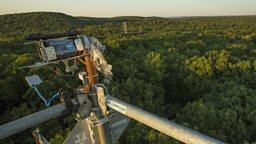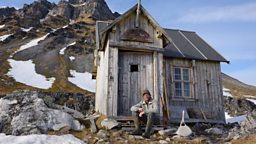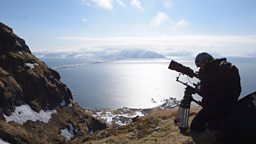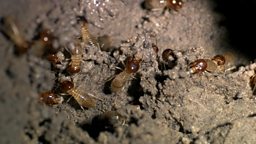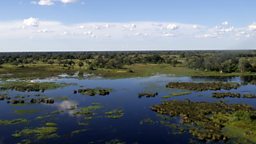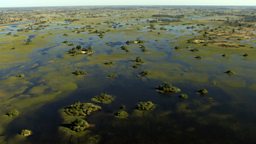Filming a wild rattlesnake hunt
Pete Abdu, remote camera operator
Filming a snake hunting in the wild is one of the most difficult moments to observe and film in nature. Most snakes eat less than once every few weeks, and when and where they will hunt is impossible to predict. We met up with biologist Dr. Anne Stengle of the University of Massachusetts who has been studying timber rattlesnakes for more than 10 years.
Treading carefully
“Very few people in New England have even seen a timber rattlesnake” Anne told us “they were actively hunted throughout New England and until the 1960’s they had a bounty on their heads”. Today they are making a comeback, with a few hundred in these forests. As part of the conservation efforts she has been studying a small population in a forest not far from Boston. Here she has tagged a small number with radio transmitters. These emit a signal that Anne can tune in to, and as the signal gets stronger it indicates that she is getting closer to a snake. With every step more caution needs to be taken. Timber rattlesnakes can be more than a meter long but they have incredibly good camouflage and can easily hide amongst the leaves. The last thing you’d want to do is step on one.
Remote cameras
We located a number of radio tagged timber rattlesnakes but only one of the snakes that we located was in a hunting position. I had built two motion-triggered camera systems to film the hunt. Around the cameras I had installed motion sensors so that if a small warm blooded mammal, like a mouse, should pass by it would trigger the cameras to start recording. The cameras were in place and all we had to do now was wait...
The lucky mouse
In the morning the snake had gone and I was disappointed to find that the only thing my cameras had filmed was a chipmunk sniffing around the exact same spot, after Vader had left the scene. So the search was on once more.
When hunting, timber rattlesnakes use their tongues to ‘sniff out’ areas with rodent activity, and then patiently wait for their prey. Anne was able to relocate Vader, and again he was poised to strike. We tracked him for 7 days and nights as he constantly changed location and position without getting a meal.
Often we had to inch on all fours through thick marshes and bogs before we could quietly set the equipment up again.
After a week of tracking Vader, Anne found him close to a fallen log. Likely being used as a runway for mice. I quickly installed the cameras. By morning, 15 hours later, the snake was in the same position. The nights footage revealed that two strikes had been made - each time he had missed a mouse, and a third, very close call, had been made less than an hour before the crew arrived. Each time the mouse had made a very lucky escape - and on the last attempt the mouse reached up and looked back at the snake over the log as if to taunt him. I left the cameras in position, as we looked for other snakes which might be hunting near by.
I had installed an alarm system so that I would be remotely alerted if the motion detection had been triggered on one of my cameras, and sure enough just a couple of hours later my alarm sounded. We rushed back to the scene.
Vader gets his meal
A small mouse had scampered down the log towards a hole, but this is what Vader had foreseen. The wait was over. His eyes focused, muscles tensed, fangs unfolding, venom ready. He struck. Surprisingly, we had caught Vader in the act as he was about to follow the mouse's scent to claim his meal and I quickly relocated one of my cameras to capture the grizzly scene.
Vaders successful hunt meant that he could head back to his den satisfied, but we left that day feeling even more triumphant, having captured a successful timber rattlesnake hunt on two remote video cameras.
This remarkable footage provided Anne a special insight into the behavior of rattlesnakes in the wild. “It was interesting to see how frequently the individual switches feeding sites” she said, “and even varies in the type of prey it’s hunting”. “After 10 years of radio-tracking rattlesnakes, I have never seen one consume prey, so this was very exciting footage to watch.” “Much of the public still fear snakes and do not value protecting them, but they are a key species in our ecosystem, and the loss of any species only weakens these ecosystems.”
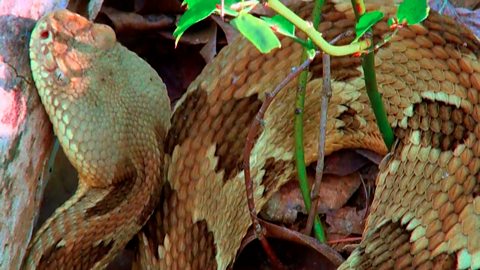
Timber rattlesnake predation
�ճ� t��������� r���ٳٱ�����Բ���� l���� i�� w�������Э�ǰ� 15 h�dzܰ����Э�ǰ� a m��.
